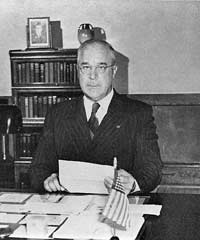Roy Ellis
President
Southwest Missouri State Teachers College
Southwest Missouri State College
1926-61
A native of Wright County in Missouri, Roy Ellis graduated from State Normal School #4 in 1911, and returned in 1917 to teach sociology and economics. Named president in 1926, Dr. Ellis served until 1961, the longest tenure of any president in the first century of the institution’s history.
Academic accreditation came to the college in 1927 when it was examined by the North Central Association and granted full status as both a liberal arts college and a teachers college. High school courses were dropped from the catalog, signaling the end of the normal school curriculum. By the 1930s, Southwest Missouri State Teachers College was the sixth largest teachers college in the United States, with an enrollment of more than 1,000 students.
While the Great Depression of the 1930s brought financial distress to both the college and its students, it also brought public works projects to campus, providing work for local citizens who built the Health and Recreation Building (McDonald Arena), a football stadium and the Olympic size-swimming pool.
World War II brought a second challenge to the college, reducing enrollment from 1,600 in 1939 to just 465 in 1943, with women outnumbering men 8 to 1. War mobilization brought an Air Corps Training program to campus with 250 cadets. By 1946, returning veterans had built the enrollment back to pre-war numbers, and as Ellis’ presidency ended in 1961, 3,433 students were crowding the 38-acre campus. Among them were African Americans, first admitted in 1954, following the Brown v. Topeka Board of Education Supreme Court decision.
In 1946, recognizing the evolving character of the institution, the legislature authorized a name change to Southwest Missouri State College. By the 1950s, the college was gaining national notoriety by placing a team in the “Olympics of Debate,” the National Debate Tournament at West Point; winning the NAIA post-season national basketball tournament in both 1952 and 1953; and having its drama production “Finian's Rainbow” selected for a USO tour.
President Ellis understood education as a great enabler, opening a new vision of life to people who had not yet fully grasped their possibilities. He understood that process as sacred, and in 1936 he referred to the campus as “the Shrine of the Ozarks.”

Dr. Roy Ellis